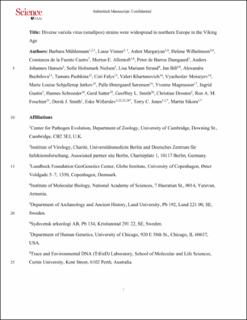| dc.contributor.author | Mühlemann, Barbara | |
| dc.contributor.author | Vinner, Lasse | |
| dc.contributor.author | Margaryan, Ashot | |
| dc.contributor.author | Wilhelmson, Helene | |
| dc.contributor.author | Castro, Constanza De La Fuente | |
| dc.contributor.author | Allentoft, Morten E. | |
| dc.contributor.author | Damgaard, Peter De Barros | |
| dc.contributor.author | Hansen, Anders J. | |
| dc.contributor.author | Nielsen, Sofie Holtsmark | |
| dc.contributor.author | Strand, Lisa Mariann | |
| dc.contributor.author | Bill, Jan | |
| dc.contributor.author | Buzhilova, Alexandra | |
| dc.contributor.author | Pushkina, Tamara | |
| dc.contributor.author | Falys, Ceri | |
| dc.contributor.author | Khartanovich, Valeri | |
| dc.contributor.author | Moiseyev, Vyacheslav | |
| dc.contributor.author | Jørkov, Marie Louise Schjellerup | |
| dc.contributor.author | Sørensen, Palle Østergaard | |
| dc.contributor.author | Magnusson, Yvonne | |
| dc.contributor.author | Gustin, Ingrid | |
| dc.contributor.author | Schroeder, Hannes | |
| dc.contributor.author | Sutter, Gerd | |
| dc.contributor.author | Smith, Geoffrey L. | |
| dc.contributor.author | Drosten, Christian | |
| dc.contributor.author | Fouchier, Ron A. M. | |
| dc.contributor.author | Smith, Derek J. | |
| dc.contributor.author | Willerslev, Eske | |
| dc.contributor.author | Jones, Terry C. | |
| dc.contributor.author | Sikora, Martin | |
| dc.date.accessioned | 2021-03-19T07:50:58Z | |
| dc.date.available | 2021-03-19T07:50:58Z | |
| dc.date.created | 2020-07-30T18:09:26Z | |
| dc.date.issued | 2020 | |
| dc.identifier.citation | Science. 2020, 369:eaaw8977 (6502), 1-12. | en_US |
| dc.identifier.issn | 0036-8075 | |
| dc.identifier.uri | https://hdl.handle.net/11250/2734375 | |
| dc.description.abstract | Humans have a notable capacity to withstand the ravages of infectious diseases. Smallpox killed millions of people but drove Jenner's invention of vaccination, which eventually led to the annihilation of this virus, declared in 1980. To investigate the history of smallpox, Mühlemann et al. obtained high-throughput shotgun sequencing data from 1867 human remains ranging from >31,000 to 150 years ago (see the Perspective by Alcamí). Thirteen positive samples emerged, 11 of which were northern European Viking Age people (6th to 7th century CE). Although the sequences were patchy and incomplete, four could be used to infer a phylogenetic tree. This showed distinct Viking Age lineages with multiple gene inactivations. The analysis pushes back the date of the earliest variola infection in humans by ∼1000 years and reveals the existence of a previously unknown virus clade. | en_US |
| dc.language.iso | eng | en_US |
| dc.publisher | American Association for the Advancement of Science | en_US |
| dc.title | Diverse variola virus (smallpox) strains were widespread in northern Europe in the Viking Age | en_US |
| dc.type | Peer reviewed | en_US |
| dc.type | Journal article | en_US |
| dc.description.version | acceptedVersion | en_US |
| dc.source.pagenumber | 1-12 | en_US |
| dc.source.volume | 369:eaaw8977 | en_US |
| dc.source.journal | Science | en_US |
| dc.source.issue | 6502 | en_US |
| dc.identifier.doi | 10.1126/science.aaw8977 | |
| dc.identifier.cristin | 1821079 | |
| dc.description.localcode | This is the author’s version of the work. It is posted here by permission of the AAAS for personal use, not for redistribution. | en_US |
| cristin.ispublished | true | |
| cristin.fulltext | postprint | |
| cristin.qualitycode | 2 | |
